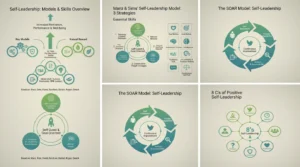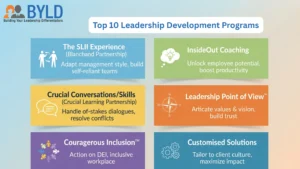
What is Active Listening?: Benefits and Types You Must Know About
- Our Subject Matter Experts
- June 30, 2025
- 3:50 pm
- No Comments

Table of Contents
In today’s busy environment, it’s easy to lose touch with real people. We hear, but do we truly pay attention? Being able to actively listen may change the way you talk to others at work, in your personal life, and in everyday discussions.
Active listening is more than simply hearing words; it’s about paying attention to the speaker and understanding their feelings, goals, and message. Active listening, on the other hand, takes work, attention, empathy, and intention. Passive hearing happens automatically and without filtering. It is one of the best ways to talk to people at work and in your personal life.
What makes active listening so important? Because it helps people work together, fosters trust, and cuts down on misunderstandings. Leaders who are good at active listening create workplaces that are open to everyone. Partners who employ active listening skills get closer to one another emotionally. Active listening makes individuals feel heard and respected, even when they’re just talking.
In this article, we’ll go over the most important parts of active listening, useful active listening strategies, how to improve your active listening abilities, and why these skills are important in every part of life. If you want to be better at connecting with people, whether you’re a student, a manager, a coach, or just someone who wants to be better at it, you’ll find the information you need to make listening your superpower.
By the conclusion of this tutorial, you’ll not only know what active listening is, but you’ll also know how to do it every day, in high-stakes situations, and get the benefits of really paying attention when you talk to someone.
What is Active Listening?
The main idea behind active listening is to give someone your complete attention so that you can really hear what they are saying, both audibly and nonverbally. It’s not about waiting for your chance to talk or coming up with an answer swiftly. It’s not about that; it’s about being there, taking in what the speaker says, and responding to their message with understanding and purpose.
Active listening is being mentally involved, emotionally alert, and responsive. Passive listening, on the other hand, means hearing what the speaker says but not necessarily understanding it. It’s not enough to merely listen to respond.
The Basic Parts of Active Listening
To get better at active listening, you need to know what makes this way of communicating work:
Attention: Listen without distractions, such as phones or multitasking, and be fully present.
Understanding means taking in the message, the situation, and the feelings underlying the words.
Responding: Showing that you understand by nodding, repeating what someone else said, or asking questions.
Retention is being able to remember the important things for future talks or decisions.
Together, these things make up the basis of a solid set of active listening abilities that can help you connect more effectively with others in both your personal and professional life.
Why It Matters
You may learn how to actively listen in a boardroom or a coffee shop.
- Make relationships with other people stronger
- Increase team morale and productivity at work
- Cut down on fights and miscommunications
- Make it easier to solve problems and make decisions
People who listen well stand out in a world where everyone wants to be heard. Improving your active listening abilities is more than simply a soft talent; it’s a way to get ahead.
Key Benefits of Active Listening
Engaging in active listening is more than just being nice; it’s a key skill that leads to stronger bonds, better understanding, and better teamwork anywhere. Whether you’re a parent, teacher, team leader, or therapist, learning how to listen actively can change your life in many ways.
1. Makes friends and builds trust
People feel heard and respected when you listen to them. For others to be more likely to open up, work together, and give honest comments, this builds trust. It helps people get along better at work, with their families, and in their neighborhoods.
2. Lessen misunderstandings
Many disagreements start with wrong ideas or words that aren’t understood. Active listening skills, like rewriting, condensing, and asking questions to get more information, lower the chance of misunderstanding. It makes sure that everyone is on the same page.
3. Makes you smarter emotionally
Recognizing the speaker’s feelings through tone of voice, body language, and other small signs is an important part of active attention. This emotional awareness makes you more empathetic, so you can react in a way that supports not only the speaker’s words but also their feelings.
4. Makes work more productive and efficient
Active listening that works well in the workplace saves time and makes things clearer. Listening carefully to directions or feedback helps people finish jobs faster and with fewer mistakes or changes. It also helps the team work together better.
5. Encourages people to talk to each other
When people feel like they are being heard, they are more likely to speak up and share new ideas. Getting better at active listening can help make a space where everyone’s voice is heard.
6. Makes leadership and influence stronger
Leaders who actively listen learn more about the problems, goals, and driving forces of their team. It also shows that you are humble and honest, which are two traits of a leader that build trust and respect.
Read More – Corporate Training Certification: Benefits and Importance
10 Types of Active Listening Everyone Should Master
To be good at active listening, you need to know how to use different styles depending on the situation, your feelings, and your goal. These 10 types cover a wide range of situations that you might encounter in real life. They will help you improve your active listening skills for personal and professional growth.
1. Listening with thought
One of the most important active listening skills is reflective attention. It means rephrasing what the speaker said to make sure you understand. Saying something like, “So what I’m hearing is…” helps both sides understand, which reduces confusion.
By making sure nothing is lost in translation, this style helps you get better at active listening.
2. Listening with empathy
When someone listens with empathy, they pay attention to how they feel, not just what they are saying. Active listening is an important part of emotional intelligence and a skill that everyone who wants to be a good leader or in a relationship needs to have.
By recognizing feelings, even if answers aren’t offered right away, this method builds a strong connection.
3. Listening with care
People often use this type of active listening in meetings, arguments, and situations where they need to make a choice. It means figuring out what the speaker is trying to say based on logic, facts, and proof while still showing respect and interest.
It’s one of the most critical ways to listen actively, and it improves judgment without ignoring the speaker.
4. Selective listening (when done right)
Selective listening might sound like a bad thing, but when done on purpose, it can help find useful information in a lot of data. As part of your active listening skills, you should be able to get to the most important parts without losing sensitivity.
Focus on it wisely while still being in the present.
5. Listening Without Prejudice
This is one of the most basic skills for active hearing. You use tone, pitch, and body language to figure out what someone is saying. It goes beyond words and connects with what people don’t say.
Important for talks with a lot at stake, where what isn’t said is just as important.
6. Listening with appreciation
Used when listening to something for fun or to get ideas, like music, a motivating talk, or a story session. Still, you have to be present and open, which improves your general ability to listen actively.
One of the best ways to improve your active listening skills is in a fun and relaxing way.
How to Change Passive Listening to Active Listening
This happens when someone hears but doesn’t respond. You can change passive listening into active listening with small changes, like asking a follow-up question. This will make every talk more important.
Being aware of when someone is quiet helps you change gears and use active listening methods on purpose.
8. Listening that helps
This type tells the speaker they can keep talking without being stopped or judged. One of the most powerful active listening skills to learn is this one, which is often used in teaching or coaching.
This method of support can include anything from silence to nods or encouraging body language.
9. Listening to everything
This type of active listening is great for training, talks, and classrooms because it requires taking in, figuring out, and sorting a lot of information. The most important skills are taking notes and asking clear questions.
Strong active listening skills include being able to put together complicated information on the spot.
10. Listening without speaking
Active listening isn’t always best when words aren’t used. Your stance, eye contact, and facial gestures can show that you are paying attention and understanding. Getting better at these silent, active listening skills will make you more present in any talk.
Ready to Strengthen Your Communication Skills?
The Psychology Behind Active Listening: Why It Works
Active hearing is based on strong psychological principles that affect how people think, behave, and connect emotionally. When you listen actively, instead of passively, you make people feel seen, heard, and respected. This isn’t just a “soft skill”; it’s a strong way to communicate that’s based on research in how people think and act.
Oxytocin, the “trust hormone,” is released in the brain of the speaker when active listening skills are used. This makes conversation more real and strengthens emotional ties. When trust grows, the person speaking feels safer, which makes them more likely to be honest and open. Being able to actively listen well helps people in management, education, counseling, and leadership build better teams and relationships that last longer.
Cognitive scientists also talk about how active listening exercises use the brain’s executive functions, which include controlling emotions, working memory, and attention. In short, when you listen fully, you’re not just processing words; you’re also controlling your feelings, blocking out distractions, and building sensitivity. This multi-level thinking helps people work together more effectively, clear up confusion, and solve problems.
Active listening also lowers the stress in talks that are already heated. The listener doesn’t reply negatively; instead, they respond with thought. The difference between surface-level contact and real knowledge is this change from reacting to reflecting.
This is more important than ever in a business setting. When you need to deal with client feedback, coach a new worker, or settle a disagreement, the best thing you can do is practice active listening. They help people find secret worries, understand what’s being said, and come up with answers that work.
When you regularly use the psychology of active listening, you not only improve communication but you also build trust, emotional intelligence, and the ability to get along with others. That’s more than a skill in the workplace today; it’s a way to stand out from the competition.
Common Barriers to Active Listening (And How to Overcome Them)
Consistently practicing active listening can be hard, even if you mean to. The process is often slowed down by psychological, environmental, and social problems. If you want to improve your active listening skills and become a better speaker, you need to understand and deal with these problems.
1. Distractions inside the head
One thing that makes active listening hard is having too much on your mind at once. Being truly present is hard to do when you’re thinking about your to-do list, planning your answer while someone else is talking, or getting lost in thoughts that have nothing to do with the present moment. To get over this, practice being aware. Before starting a talk, clear your thoughts, take a deep breath, and turn your attention to the person speaking. The first step in any good active hearing method is to be present.
2. Noise from Outside
Notifications, background noise, or a messy setting can make it hard to listen carefully. These outside influences weaken the effectiveness of careful listening. Setting up a place that is quiet and doesn’t have any interruptions can greatly improve listening results, especially in business settings.
3. Judgement or Favoritism
Having ideas about the person or the subject before hearing them can make it hard to understand. You are not listening if you are judging. Active viewers must keep an open mind and not make any assumptions in order to fully understand the speaker’s point of view. To learn the active listening skillset, you need to take this nonjudgmental method.
4. Sources of Emotion
Sometimes, a speaker may touch on personal issues without meaning to. Feelings like anger, fear, or defensiveness can make it hard to talk to someone. Self-awareness and controlling your emotions are very important in this situation. You can stay busy while listening, even when things are getting tough. For example, you can pause before you answer or name your feelings in your mind.
5. No one is giving feedback
Feedback is an important part of careful listening. People who speak up may feel ignored if they don’t get verbal or nonverbal reinforcement (nodding, paraphrasing, or explaining). People who are active listeners show that they are interested through their body language, encouraging sounds (like “I see” or “Go on”), and thoughtful answers.
6. Culture of Multitasking
People often think that juggling is useful in today’s digital world, but it’s bad for conversation. Any active listening method you try will fail if you check your email or phone during a discussion. Single-tasking is not a weakness; it’s a key part of being polite and getting things done.
7. Barriers caused by language or culture
When people speak, write, or sound differently, it can lead to misunderstandings. A really good active listener changes what they’re saying by asking questions to make things clearer, reviewing important points, and changing their tone and pace to make sure everyone understands.
Overcoming these problems takes a steady focus and dedication. But once you know how to do it, active listening can make any talk, no matter how complicated, into a valuable and useful exchange.
How Active Listening Impacts Personal and Professional Relationships
Listening actively is more than just hearing what someone says; it’s about building trust, understanding, and respect between people in every exchange. When done regularly, it changes things for the better in both personal relationships and the job.
1. Makes emotional connections stronger
Active listening skills show that you care about someone in a personal connection. When you intentionally listen, you show that you understand how your partner feels and are there for them emotionally. This makes things more personal and makes it safe to talk freely. Being fully present can have a lasting effect, whether it’s a friend talking about a problem they’re having or a loved one sharing happiness.
2. Makes it easier to solve problems
There will always be disagreements, but how we deal with them is important. When there is a disagreement, repeating the other person’s point of view before you answer is one of the best ways to practice active listening. There’s more to it than just waiting to talk. It shows you want to understand. This makes people less angry and encourages calm, problem-solving conversations. Active listening can help ease stress and encourage teamwork at home or at the office.
3. Helps people trust each other at work
People respect a boss or team member who constantly listens in the workplace. People who work for you feel heard, respected, and more involved. As a boss, improving your active listening skills will help your team communicate better, boost happiness, and get more done. Listening to concerns, opinions, or requests from clients is also very important because it can directly affect how happy and loyal they are.
4. Helps teams work together better
Teams work best when everyone understands and works with each other. Active listening methods, such as asking clarifying questions, noticing nonverbal cues, and outlining shared goals, make it easier for people to work together. It gets rid of expectations and makes sure everyone is on the same page, which leads to better decisions and more creative ideas.
5. Supports a culture of open feedback
A system of feedback works best when people listen actively all the time. When partners or workers feel like their ideas are really being thought about, they are more likely to speak up. This encourages new ideas, boosts growth, and creates an environment where everyone feels like their voice is heard.
6. Helps you grow as a person
Lastly, being able to listen actively helps you grow as a person. You can get new ideas, fight biases, and improve your emotional intelligence by really hearing what other people have to say. Being self-aware improves the way you talk to people, making you a better partner, friend, boss, and person overall.
Real-World Examples of Active Listening in Action
Before we really understand how powerful active listening is, let’s look at some real-life examples of how it changes relationships and results.
1. Workplace: The Boss Who Pays Attention
Take the role of a team boss who notices that employees are less motivated. The boss doesn’t jump to assumptions. Instead, he or she has one-on-one meetings and uses active listening skills like giving full attention, nodding, and summarizing concerns. In this way, the manager finds deeper problems, such as an imbalance of work and confusing goals, and gets everyone to work together to fix them. This shows how important active listening skills are for leaders, as it boosts happiness and productivity.
2. Customer Service: How to Turn Complaints Into Loyalty
A customer calls to report that their order was late. When an agent uses active listening skills, they calmly listen without talking over the person, acknowledge their anger, and repeat the main points to show that they understand. The customer feels like they were heard and appreciated, which turns a bad experience into brand love. This example shows how important it is to actively listen in order to build long-lasting relationships with customers.
3. The Helpful Friend in Personal Relationships
A friend talks about their fears about something tough. Instead of giving help when they haven’t asked for it, you use active listening techniques like making eye contact, not judging, and asking open-ended questions to get them to say everything they want to say. Listening with empathy makes your relationship stronger and helps your friend feel better.
4. In health care, doctors are giving better care to patients
By letting patients talk without cutting them off, doctors who know how to actively listen get more accurate information. This leads to more accurate evaluations and better plans for care. This shows that active listening has a direct effect on health results by making patients feel accepted and more at ease when they share private information.
5. How to Find Win-Win Solutions in Negotiations
People who are good at negotiating actively listen to understand the other side’s worries and goals. This helps come up with answers that work for everyone instead of pushing a single point of view. Active listening skills, like reviewing points and clearing up any confusion, help people get to know each other and trust each other, which makes it more likely that they will agree.
6. In education, teachers make learning better
Active listening teachers urge their students to say what they think without holding back. By thinking about and agreeing with what students say, teachers make the classroom a safe place to learn where interest grows. This makes people more interested and helps them learn better.
These examples make it clear that learning how to listen actively can change the way you interact with others in every part of your life.
Read More – What is Leadership Development? Its Definition, Importance, and Benefits
Conclusion
Learning how to listen actively is important for communicating well in all areas of life. Being able to truly hear, understand, and react carefully can change interactions and results, whether they happen at work, in a personal relationship, or in a high-stakes situation. Being able to actively listen builds trust, clears up confusion, and encourages openness, all of which lead to stronger relationships and better problem-solving.
It takes work, patience, and understanding to listen actively instead of just passively. Focused attention, thoughtful feedback, and clarifying questions are all tried-and-true active listening methods that people can use to better understand and create a conversation-friendly space. This set of skills gives leaders, teachers, healthcare workers, and regular people who talk to each other the power to connect more deeply and react with insight.
Distractions, expectations, and biases can get in the way of active listening, but identifying and dealing with these problems makes it easier to connect. Active hearing is a timeless and useful skill that helps us have clear and caring talks even as technology and communication change.
Practicing active listening not only makes speaking better, but it also strengthens relationships, encourages teamwork, and helps you grow as a person and in your career. Try active listening today and see how much of a difference it makes in your life.






